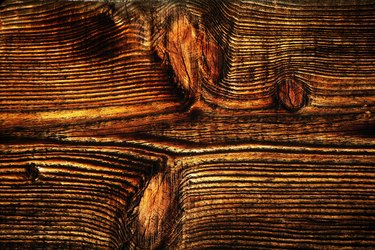
George Nakashima (1905-1990) was a trained architect famous for furnishings he made typically with natural wood. He regarded the processes surrounding the selection, cutting, drying and use of fine timbers as "giving new life to the tree." Nakashima worked primarily with hand tools and often left the edges of his tables natural, or "free." Knowing the signature characteristics of George Nakashima's furniture can help you identify the likelihood that he made a particular table.
The Signature
Video of the Day
A key issue concerning the identification of a Nakashima table is that during his career he rarely signed his work. On occasion, he signed it, but more often, he simply wrote the name of his client in black marker on the underside of the piece of timber he and the client had selected from his workshop. This mark, as well as an order card and perhaps a shop drawing, are three key components important in identifying Nakashima works today.
Video of the Day
The Butterfly Joint
Nakashima tables often contain examples of his working methods that are characteristic to his approach to making furniture. One element, the "butterfly" joint, is a geometric butterfly-shaped component that joined two pieces of timber together. You can see examples of this joint in table designs such as the "Trestle" table and the "Conold" table, both of which are still available from the Nakashima studio. References to the use of butterfly joints occur throughout Nakashima's written philosophy, with direct passages mentioning "butterfly-shaped inlays."
Book-Matched Timber
Another key characteristic of Nakashima tables is his frequent use of book-matched timber, which means that the boards he used to construct a piece of furniture were often cut sequentially from the same log. This type of cut meant that when the pieces were opened up side-by-side, they had wood grain that mirrored each other. Nakashima wrote that, "It is possible to book-match two, four and sometimes with luck, six boards." He believed that boards that were not book-matched were "dull and uninteresting."
Drawings, Photographs, Provenance
Perhaps the single most definitive element in identifying a Nakashima table is the existence of a sketch, drawing or other record from the artist or his studio. Since the studio still produces new works, pieces completed posthumously are all signed and dated. A 1967 "Frenchman's Cove" table was featured in 2009 on the PBS program, "Antiques Roadshow," with both a sketch and Nakashima's handwritten order. Nakashima's sketches included exquisite details, even down to the number of butterfly joints a particular book-matched timber table might require.
- George Nakashima Woodworker: Philosophy
- Design Miami: Focus on George Nakashima
- Blouin Art Info: On the "Particular Destiny" of Designer George Nakashima's Craft Woodworking
- Heirloom Woodcrafting: Bookmatched Lumber
- PBS.org: Antiques Roadshow: Follow the Stories: Sketch of Frenchman's Cove Table by George Nakashima
- The New York Times: A Solid, Comforting Family Member: Goodbye, Mr. Nakashima
- Design Within Reach: George Nakashima